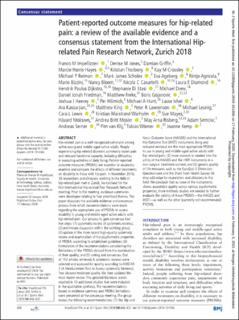| dc.contributor.author | Impellizzeri, Franco M. | |
| dc.contributor.author | Jones, Denise M. | |
| dc.contributor.author | Griffin, Damian | |
| dc.contributor.author | Harris-Hayes, Marcie | |
| dc.contributor.author | Thorborg, Kristian | |
| dc.contributor.author | Crossley, Kay M. | |
| dc.contributor.author | Reiman, Michael P. | |
| dc.contributor.author | Scholes, Mark James | |
| dc.contributor.author | Ageberg, Eva | |
| dc.contributor.author | Agricola, Rintje | |
| dc.contributor.author | Bizzini, Mario | |
| dc.contributor.author | Bloom, Nancy | |
| dc.contributor.author | Casartelli, Nicola C. | |
| dc.contributor.author | Diamond, Laura E. | |
| dc.contributor.author | Dijkstra, Hendrik Paulus | |
| dc.contributor.author | Di Stasi, Stephanie | |
| dc.contributor.author | Drew, Michael | |
| dc.contributor.author | Friedman, Daniel J. | |
| dc.contributor.author | Freke, Matthew | |
| dc.contributor.author | Gojanovic, Boris | |
| dc.contributor.author | Heerey, Joshua J. | |
| dc.contributor.author | Hölmich, Per | |
| dc.contributor.author | Hunt, Michael A. | |
| dc.contributor.author | Ishøi, Lasse | |
| dc.contributor.author | Kassarjian, Ara | |
| dc.contributor.author | King, Matthew | |
| dc.contributor.author | Lawrenson, Peter R. | |
| dc.contributor.author | Leunig, Michael | |
| dc.contributor.author | Lewis, Cara L. | |
| dc.contributor.author | Warholm, Kristian Marstrand | |
| dc.contributor.author | Mayes, Sue | |
| dc.contributor.author | Moksnes, Håvard | |
| dc.contributor.author | Mosler, Andrea Britt | |
| dc.contributor.author | Risberg, May Arna | |
| dc.contributor.author | Semciw, Adam | |
| dc.contributor.author | Serner, Andreas | |
| dc.contributor.author | van Klij, Pim | |
| dc.contributor.author | Wörner, Tobias | |
| dc.contributor.author | Kemp, Joanne | |
| dc.date.accessioned | 2021-02-09T14:15:38Z | |
| dc.date.available | 2021-02-09T14:15:38Z | |
| dc.date.created | 2020-11-13T11:04:31Z | |
| dc.date.issued | 2020 | |
| dc.identifier.citation | British Journal of Sports Medicine. 2020, 54(14), 848-857. | en_US |
| dc.identifier.issn | 0306-3674 | |
| dc.identifier.uri | https://hdl.handle.net/11250/2726959 | |
| dc.description | Free BMJ article. No commercial re-use. | en_US |
| dc.description.abstract | Hip-related pain is a well-recognised complaint among active young and middle-aged active adults. People experiencing hip-related disorders commonly report pain and reduced functional capacity, including difficulties in executing activities of daily living. Patient-reported outcome measures (PROMs) are essential to accurately examine and compare the effects of different treatments on disability in those with hip pain. In November 2018, 38 researchers and clinicians working in the field of hip-related pain met in Zurich, Switzerland for the first International Hip-related Pain Research Network meeting. Prior to the meeting, evidence summaries were developed relating to four prioritised themes. This paper discusses the available evidence and consensus process from which recommendations were made regarding the appropriate use of PROMs to assess disability in young and middle-aged active adults with hip-related pain. Our process to gain consensus had five steps: (1) systematic review of systematic reviews; (2) preliminary discussion within the working group; (3) update of the more recent high-quality systematic review and examination of the psychometric properties of PROMs according to established guidelines; (4) formulation of the recommendations considering the limitations of the PROMs derived from the examination of their quality; and (5) voting and consensus. Out of 102 articles retrieved, 6 systematic reviews were selected and assessed for quality according to AMSTAR 2 (A MeaSurement Tool to Assess systematic Reviews). Two showed moderate quality. We then updated the most recent review. The updated literature search resulted in 10 additional studies that were included in the qualitative synthesis. The recommendations based on evidence summary and PROMs limitations were presented at the consensus meeting. The group makes the following recommendations: (1) the Hip and Groin Outcome Score (HAGOS) and the International Hip Outcome Tool (iHOT) instruments (long and reduced versions) are the most appropriate PROMs to use in young and middle-aged active adults with hip-related pain; (2) more research is needed into the utility of the HAGOS and the iHOT instruments in a non-surgical treatment context; and (3) generic quality of life measures such as the EuroQoL-5 Dimension Questionnaire and the Short Form Health Survey-36 may add value for researchers and clinicians in this field. We conclude that as none of the instruments shows acceptable quality across various psychometric properties, more methods studies are needed to further evaluate the validity of these PROMS—the HAGOS and iHOT—as well as the other (currently not recommended) PROMS. | en_US |
| dc.language.iso | eng | en_US |
| dc.subject | consensus | en_US |
| dc.subject | groin | en_US |
| dc.subject | hip | en_US |
| dc.subject | quality of life | en_US |
| dc.subject | questionnaire | en_US |
| dc.title | Patient-reported outcome measures for hip-related pain: a review of the available evidence and a consensus statement from the International Hip-related Pain Research Network, Zurich 2018 | en_US |
| dc.type | Peer reviewed | en_US |
| dc.type | Journal article | en_US |
| dc.description.version | publishedVersion | en_US |
| dc.source.pagenumber | 10 | en_US |
| dc.source.journal | British Journal of Sports Medicine | en_US |
| dc.identifier.doi | 10.1136/bjsports-2019-101456 | |
| dc.identifier.cristin | 1847666 | |
| dc.description.localcode | Institutt for idrettsmedisinske fag / Department of Sports Medicine | en_US |
| cristin.ispublished | true | |
| cristin.fulltext | original | |
| cristin.qualitycode | 2 | |
